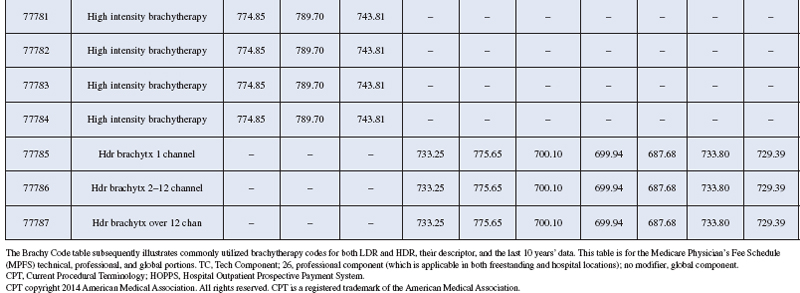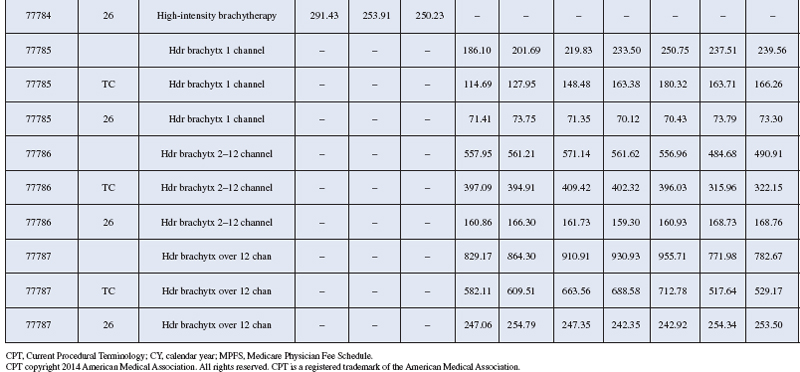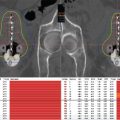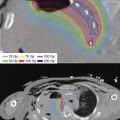15
Foundations of a Brachytherapy Practice
David Jeffrey Demanes, Ron DiGiaimo, Casilda Menchaca-Garcia, and Tamara Syverson
The purpose of this chapter is to describe the prerequisites and methods for establishing a successful high-quality brachytherapy service. The chapter covers the following topics.
1. Training and Education
2. Brachytherapy Specialty Practice Planning and Development
3. How to Begin Strategic Planning Specific to Brachytherapy
4. Organization and Resources
5. Business Plan for a Brachytherapy Service
6. Establishing a Fee Schedule
7. Managed Care Restrictions and Negotiations
8. Compliance Requirements
9. Denial Management
10. Key Financial Indicators and Definitions
11. Coding Brachytherapy Procedures
12. Conclusion
Disclaimer: This chapter refers to current clinical reimbursement codes and charges to illustrate establishment of a business plan for clinical brachytherapy. Payment policies for brachytherapy vary widely within the United States and around the world. The information contained in this chapter (although accurate at the time of printing) may not be universally applicable; and payer policies are likely to change with time. In addition, there are acceptable variations in physician and hospital practices concerning clinical brachytherapy procedures, which may affect the nature of the services rendered and the associated reimbursement. Before the submission of a claim, the reader should contact the commercial or government payer (eg, Medicare, Medicaid) to verify applicable codes, coverage policies, and payment amounts for brachytherapy. The authors and the publisher of this book assume no responsibility for the consequences related to the use of information contained in this chapter.
TRAINING AND EDUCATION
The foundation of a quality brachytherapy practice is proper training and experience in the procedures, methods, and clinical care requirements. The current residency requirements for privileges to perform brachytherapy are involvement with 15 intracavitary and five interstitial implants during a 4-year residency. As with most procedural services, the physician may or may not have received sufficient experience in residency training to begin comprehensive or even a selective brachytherapy practice. Short-term observational study programs are available at centers of excellence; the American Brachytherapy Society (ABS; www.americanbrachytherapy.org/) sponsors a 1 week observational fellowship available to selected candidates and regular site-specific brachytherapy courses. A yearlong, in-depth, brachytherapy fellowship is ideal, but such training is not practicable for most radiation oncology resident graduates. Plans for starting a brachytherapy service should include arrangements to obtain training in the particular type of brachytherapy under consideration. Whenever possible, support and assistance by a brachytherapy expert will facilitate the initial effort.
Brachytherapy typically includes an operative (brachytherapy) procedure, simulation radiography, computerized dosimetry, and delivery of the radiation source. The physician must be competent to manage the patient in the perioperative settings and be able to address procedural complications and acute radiation reactions. Late side effects of treatment usually require multidisciplinary care, where the brachytherapist should maintain direct contact and a visible interest in the outcome of the patients. Clinical brachytherapy skills improve with time; there is no better teacher than well-considered experience. There is currently no ABR fellowship designation for brachytherapy.
The physician not only needs proper training and experience but so does the entire brachytherapy team which, at minimum, consists of a medical physicist, radiation therapist (RTT), and a registered nurse (RN). Accurate dosimetry, proper treatment delivery, and clinical nursing care are essential components of brachytherapy. Additional personnel (based on the complexity and volume of cases) may include a dedicated brachytherapy dosimetrist who works under the direction of a medical physicist, a physician’s assistant (PA) or a nurse practitioner (NP) who works closely with the physician, and a licensed vocational nurse (LVN), or medical assistant (MA). Each of these team members must have sufficient experience in the care of brachytherapy patients in order to provide the care in a safe and effective manner.
Like physicians, there are no formal credentials given in brachytherapy for physicists and other nonphysicians. Expertise in brachytherapy, therefore, must come with on-the-job training, in-services available brachytherapy courses, and, of course, experience. The entire brachytherapy team will optimally refine their skills through the regular performance of brachytherapy procedures under the supervision of an experienced physician.
When implementing a new technology or modality, it is advisable to take the time necessary to learn about the equipment and how to properly use it. This may translate to mean several days away from the clinic at a manufacturer’s training facility or time spent with the technical specialist at the treating institution. Regular radiation safety exercises are important, especially for inexperienced and new staff; for the high dose rate (HDR) afterloader, regular in-services about the equipment are mandatory. Special “authorized user” status is granted by State Health Agencies. The authorized user credentials are necessary for the physician who supervises the delivery of radiation sources to the patient. The physicist will typically coordinate equipment in-services, manage radioactive materials licenses, and monitor radiation safety policies.
BRACHYTHERAPY SPECIALTY PRACTICE PLANNING AND DEVELOPMENT
Determination of the Range of Services Provided
Development of a brachytherapy service requires strategic and tactical planning. The rationale for initiating a service is based on the clinical needs of the patients in the community and the vision and belief by the physicians that such treatments are valuable. Brachytherapy is applicable to any body site where localized radiation therapy is indicated. The safety and efficacy of brachytherapy are based on years of clinical experience and are supported by literature presented elsewhere in this book.
Brachytherapy has a significant role in the primary treatment of common diagnoses such as prostate, breast, skin, and gynecologic cancers. It is also utilized in cancers of the head and neck (H/N), sarcoma, anorectal, and other sites. It can be used in palliative situations and for patients who have previously received radiation therapy. The diversity of local clinical oncology practices and variation in resources may impact the development of a brachytherapy service in your community. The radiation oncologists should purposefully decide what kind of brachytherapy is going to be offered by the practice.
Analysis of patient demographics and case mix is the first step in deciding how to expand the practice. Second, a review of the number and kinds of brachytherapy services currently being provided by the practice should be made. Third is to determine what cases are being referred elsewhere for brachytherapy and to decide if they can be properly managed at the local facility or if it is preferable to refer them to centers of excellence. Fourth, knowledge of what oncology services is already being provided in the community can lead to charting the development of a new brachytherapy service. Cancers with high relative incidences where brachytherapy has a role are prime candidates for practice development.
Referral Networks and Promotion With Referring Physicians
Cooperation with other medical and surgical specialists is essential to practice development. It can vary from simple case referral to a simultaneous participation in a multidisciplinary clinic. The physicians may manage the patients sequentially and or be directly involved in the brachytherapy procedure. Examples of procedural cooperation include endoscopy with pulmonologist (endobronchial) or gastroenterologist (intraesophageal) applications, transperineal prostate brachytherapy with urologists, and a diversity of surgeries where the radiation oncologist (brachytherapist) participates as co-surgeon during intraoperative brachytherapy.
Active interdisciplinary discussions and presentations to colleagues about the benefits of brachytherapy are valuable adjuncts to the development of a brachytherapy practice. They can be generic about brachytherapy or disease-site specific, but they help generate the interest and motivate other physicians to refer patients and participate in brachytherapy procedures. Strategic management of competing specialty practices can be effectively addressed by providing equal opportunity for participation. Inevitably, there will be diversity among colleagues so that some physicians will be more interested and involved than others. Long-term maintenance of an open door policy is best for patient access and it will lead to more uniformity in the quality of patient care in your community.
Regional Collaboration
Regional collaboration is an opportunity to develop a brachytherapy practice. Perhaps there are certain types of brachytherapy that other radiation oncologists in the region would prefer not to do. It is an opportunity for colleagues to collaborate where external beam is performed at one institution and the brachytherapy at another.
Facilities and Administrative Support
Hospital facilities and freestanding medical practices provide different physical layouts and variable capacities for providing and managing brachytherapy services. Some types of brachytherapy are feasible in outpatient settings, while others are not. Whether a certain type of brachytherapy can be performed at a particular facility depends on the anesthesia requirements, the type of radiation delivery system, and the location and duration that the implant must remain in the patient. Intracavity vaginal applications and brachytherapy of skin lesions, for example, can often be performed entirely as outpatient as a series of applications using little or no sedation. Other implants, such as endoscopy-based brachytherapy, can be done as serial same-day outpatient procedures, but they require moderate sedation in a suitable endoscopy venue (freestanding or hospital). Permanent seed prostate implants typically require anesthesia, but they do not require an overnight stay, so they are suitably performed in an ambulatory surgery center (ASC) or a hospital. Breast brachytherapy can be done either in the clinic under local anesthesia with or without sedation or done in the operating room depending on the type of applicator and the experience of the brachytherapy specialist. Hospital facilities are typically more able to manage the full-range brachytherapy services where there is a need for anesthesia, surgery, or inpatient care. Major interstitial implants of the H/N, abdomen, or pelvis mostly require inpatient facility resources, and patients who have pelvic template applicators are generally confined to bed rest and are usually done in a hospital. Cases where brachytherapy is performed in conjunction with major surgery also require the use of a hospital facility.
Administrative support (hospital or freestanding center) is essential for a successful brachytherapy service. A fully developed program requires special equipment, personnel, and the integration of many hospital or clinic services. To start a program, administrators usually like to have discussions framed in the context of a financial proforma (a tally of expenses and reimbursements). For the service to run properly, there must be a brachytherapy practice budget and regular administrative management and it is advisable to have regular strategic planning meetings with the key administrators or organizational leadership.
HOW TO BEGIN STRATEGIC PLANNING SPECIFIC TO BRACHYTHERAPY
Brachytherapy Strategic Planning
Development of a brachytherapy service sequentially by disease site and from more simple to more complex types is a good strategy to allow the team to acquire the necessary level of clinical expertise and business experience to rationally expand the program. Not all centers will want to develop the capacity or gain the experience to manage complex cases. A referral network to brachytherapy centers of excellence should be created. Know and respect your limits; they can best be expanded as you gain experience. Strategic planning is crucial to the successful implementation of new brachytherapy services. A written project outline, accompanied by a plan summary can be helpful in organizing the development process. Lists of potential referral sources should be compiled and can be the focus of education and practice promotion. Identification of regional forums such as local conferences, support groups, and tumor boards all represent opportunities to educate patients, colleagues, and hospitals about the potential benefits of brachytherapy. Advice from equipment manufacturers and input from consultants with expertise in brachytherapy billing and coding on practice management is recommended. A strengths, weaknesses, opportunities, and threats (SWOT) analysis may be a useful business tool and can help to visualize an overall plan come to fruition.
Assessment of demographics and estimation of the potential case volume can be complicated. Understanding the mixture of payers served by the medical community and knowledge of their various reimbursement policies is a fundamental practice planning exercise. It is equally important to critically and specifically evaluate managed care contracts, which determine in-network status and establish physician access to the payer’s clients. All of these factors can significantly impact the practice volume, affect the economic viability, and ultimately determine the success or failure of a brachytherapy practice. For these reasons, we recommend a feasibility study utilizing all the aforementioned factors and potential additional factors that are site specific.
Data Collection and Access to Managed Care
The collection of local regional population statistics or a feasibility study designed from cancer demographics can provide insight into the projected case mix and viability of competition. Large amounts of data are readily available via the web and target community statistics may be obtained from the hospital or state tumor registrars. Additional refining of the data may be accomplished by interviews of community physicians and cancer patient advocate or support groups. There are companies that specialize in accumulation of such data that can be purchased for analysis and comparison against local, state, and national patterns. The American Cancer Society (ACS), The National Cancer Institute’s Surveillance Epidemiology and End Results (SEER; seer.cancer.gov/) database presents survival, mortality, incidence, locality, and historic trends. Another useful resource for such information is the National Cancer Database (NCDB; www.facs.org/cancer/ncdb/), which states that “The National Cancer Data Base (NCDB), a joint program of the Commission on Cancer (CoC) of the American College of Surgeons (ACoS) and the ACS, is a nationwide oncology outcomes database for more than 1,500 Commission-accredited cancer programs in the United States and Puerto Rico. Some 70 percent of all newly diagnosed cases of cancer in the United States are captured at the institutional level and reported to the NCDB. The NCDB, begun in 1989, now contains approximately 29 million records from hospital cancer registries across the United States. Data on all types of cancer are tracked and analyzed. These data are used to explore trends in cancer care, to create regional and state benchmarks for participating hospitals, and to serve as the basis for quality improvement.” These cumulative data can be used to prepare feasibility studies of which type of brachytherapy might be relevant in a particular geographic region. Finally, there are several oncology consulting firms that are able to provide a written analysis and associated proforma with recommendations to the zip code customized data that may be relevant to your analysis.
Understanding the payer mix, variability, and trending is an essential part of the practice proforma analysis. A percentage of cases will present from managed care systems of pre-authorized referrals. Access to managed care patients and negotiation of payment rates with these organizations are necessary prerequisites to the establishment of realistic projections. In addition, traditional Medicare “fee-for-service” generally accounts for 40% to 60% of payments in radiation oncology. The Medicare Advantage programs are differentiated from traditional Medicare in that the individual insured’s coverage and participating provider are determined by the managed care organization and policy type, not Medicare, although the Medicare rates may be utilized as benchmarks for payment. Participation in as many (fairly priced) commercial insurance programs (with and without managed care) as possible will be an important determinant of the financial viability of the service line. At the time of publication accountable care organizations (ACOs), do not have a significant national impact on brachytherapy procedures specifically, but this situation may change in the coming years and their impact on brachytherapy services should be carefully considered.
Although participation within a particular payer’s network is advisable, assuming a fairly contracted and negotiated payment, it is still possible to obtain out-of-network coverage for some patients. Managed care companies provide somewhat standard but customizable provider agreements. Careful analysis with regard to obligations and local and national competitive rates must be examined with respect to volume and payments to determine if participation is a benefit or hindrance to the financial viability of the practice. Out-of-network payment agreements can be accomplished on a per-patient basis; however, heavy volume in these types of patients may become a cost-prohibitive option when staff time is taken into consideration. One must determine the threshold where participation as a preferred provider may be a better alternative. When preparing for a negotiation, one should accumulate as much historical data as possible about payment rates and should estimate the percentage of payment that will come from Medicare. The following Tables 15.1 and 15.2 illustrate Hospital Outpatient Prospective Payment System (HOPPS) rates and Medicare Physician Fee Schedule (MPFS) rates that cover several years. They show trends and gives you the opportunity to lock in rates based on a specific year’s reimbursement. For example, you may elect to negotiate 124% of 2012 reimbursement rates. Although sometimes payment is “nonnegotiable,” diligence and preparation will put you in a better position for a positive outcome. The trending tables 15.1 and 15.2 illustrate commonly utilized brachytherapy codes for both low dose rate (LDR) and HDR and their descriptors for the last 10 years. The HOPPS table shows just the technical component payment amount. The physician payments are found in the MPFS table.
Table 15.1 Ten-year trending table for HOPPS technical component
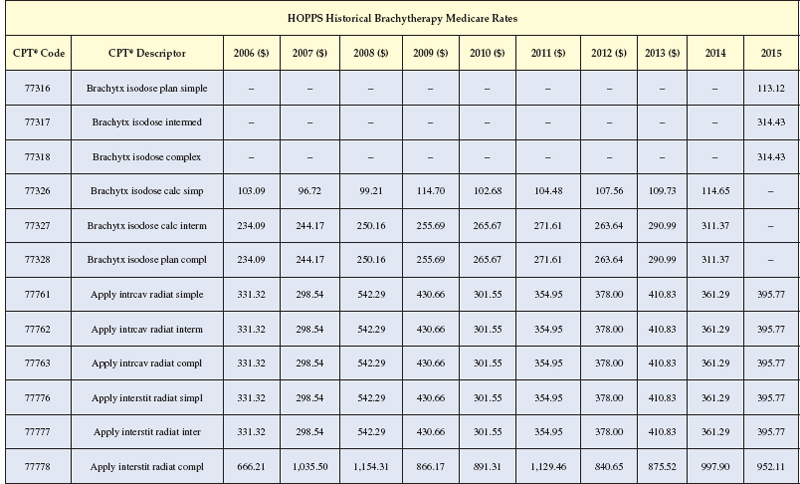
Table 15.2 Ten-year trending table for technical, professional, and global component MPFS
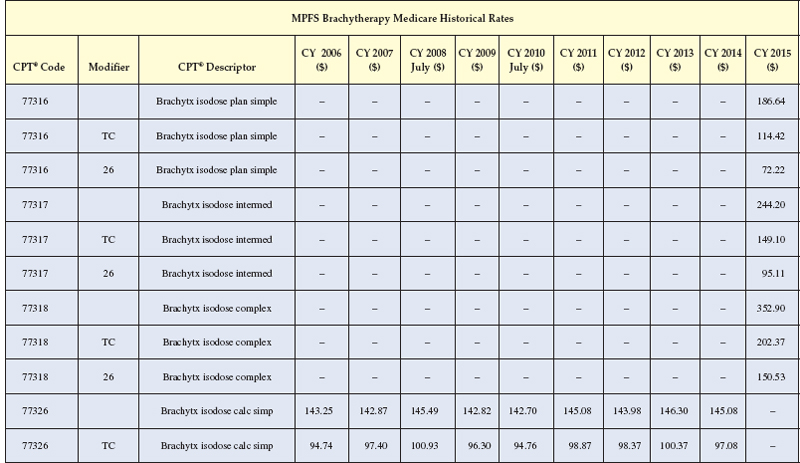
Referring Community, Education, and Practice Development
Brachytherapy is a common treatment type in a multimodality treatment program. In some cases, however, it is one of the several treatment options presented to the patient for consideration. In the case of multimodality treatment, the physician has the opportunity to interact with and educate other specialists on the value of brachytherapy on specific patients and in general. Referring physician and complete physician lists should be compiled for the practice from which invitations for individual or group interactions can be generated and distributed for special tumor board or a grand rounds focusing on brachytherapy. Importantly, for those patients where brachytherapy is a sole treatment, there is still opportunity for meaningful interaction with other specialists. For example, prostate seed implants or HDR prostate monotherapy procedures involve both the radiation oncologist and the urologist who together provide a combined expertise to achieve optimal patient outcomes. These interactions are, in and of themselves, a good opportunity to share knowledge and ideas about brachytherapy and those diseases for which it is indicated. There is no more powerful vehicles for practice development than the support and informed beliefs by your colleagues that brachytherapy is either an essential component or one of the best available treatment options for their patients.
As with many cancers, the potential brachytherapy patient is faced with a difficult decision to choose among several valid treatment options. Patients have become increasingly aware of data and alternatives because of increased media coverage and access to internet searches. Opportunities to educate patients through medical websites and referral to peer-reviewed journal articles are greater than ever before. Payers are also aware and interested in data that support the use of brachytherapy in their customers as they are routinely searching for higher or equal quality with lower cost. They typically have medical advisers and committees that review the literature and make judgments on the level of medical evidence that supports various types of brachytherapy that are periodically updated in various forums. Not unexpectedly, there is sometimes a lag between the development of evidence for brachytherapy and the payer policy. It is recommended you compile and maintain a database on the current evidence for various kinds of brachytherapy to present to the payers (typically in the form of appeal letters about individual cases).
Competitive Forces
Competition has always been and continues to be a fact of medical business life. It is, therefore, necessary in medicine, as in other businesses, to analyze the market forces to understand motivations of other providers, managed care systems, and large health care systems. It is advisable to make an assessment of the competition and to study the business and clinical practice relationships of your colleagues to radiation oncology services in your community. Nonradiation therapy providers such as primary care, family practice, and specialists such as urologists, surgeons, and medical oncologists typically control the referrals to radiation oncology. Some or most of these providers may be unfamiliar with brachytherapy. Specialists who make the diagnosis through performing biopsies or surgery (cancer diagnosis) have the first opportunity to present treatment options to the patient. Their understanding of the role and their belief in the benefits of brachytherapy are important in making a successful brachytherapy practice.
Similarly, competition within the radiation oncology specialty is a relevant consideration. In an ever-increasing competitive environment, other radiation oncologists may see brachytherapy as an opportunity for collaborative benefit for the community or, alternatively, may be viewed as a threat to their current patient volumes. Depending on the circumstances, joint ventures with other physicians may be possible to create a functional relationship that provides better service and greater patient access to quality cancer care.
Regardless of the scenario, a feasibility study with applicable diagnoses available as well as their complexity level will be beneficial in the creation of both a budget and a business plan. Table 15.3 is an example of data that would benefit a pro and con review for potential expansion in brachytherapy.
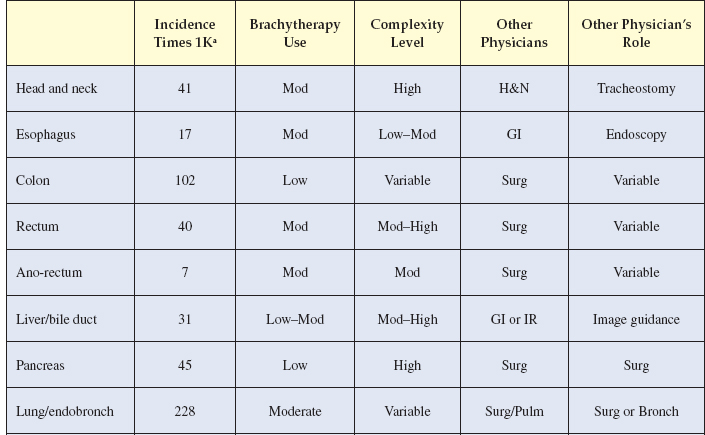
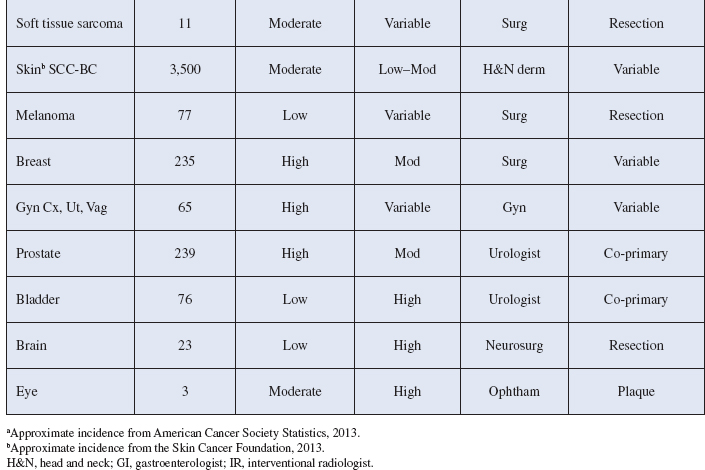
Brachytherapy Data Registry
Creation of a system within the practice to track brachytherapy (and other radiation oncology services) is a tool for education and a means for accumulation of medical evidence in support of brachytherapy. Tracking cases and outcomes in the form of a data registry allows the physician to improve individual practice and to generate outcome reports that can be used for presentations, abstracts, and publications in peer review journals. This information can be conveyed directly to the patients, to physicians in the community, to the hospital administrators, and to the payers. Electronic medical record systems have the potential to collect and manage data and if properly programmed can be used in “point of contact” data entry.
ORGANIZATION AND RESOURCES
Personnel
A brachytherapy service requires a team of personnel with a variety of skill sets. These personnel manage the multiple steps in the process of brachytherapy. These core personnel may be classified into three groups; (a) clinical; (b) physics, dosimetry, and therapy; and (c) administrative.
Clinical (Physicians, PAs, NPs, RNs, and MAs)
Radiation oncologists (brachytherapy specialists or practitioners) must have the brachytherapy procedural knowledge and skills necessary to insert the applicators, manage the patients, and administer radiation therapy as an authorized user of radioactive materials or its electronic counterpart termed electronic brachytherapy. These activities include integration of care with external beam radiotherapy (EBRT), coordination with other physicians and surgeons, selection of the proper brachytherapy methods, and clinical case management before, during, and after the procedure. The physician is at center stage in a brachytherapy program where training in procedures and radiation therapy will be applied. The patient will first be seen in consultation where the physician will decide if radiation therapy is indicated. The type and timing of external radiation and brachytherapy and their integration with other treatment modalities are part of the cognitive process of clinical treatment planning. The physician will then guide, direct, and supervise the brachytherapy from start to finish and be responsible for follow-up care of the brachytherapy patient.
PAs and NPs can be trained to do many of the evaluation and management services associated with brachytherapy in order to increase efficiency within the department. They can see patients independently, order and evaluate tests, order medications, and interact directly with patients and other physicians to coordinate care and manage patients. PAs can assistant and do some surgical procedures, but only the radiation oncologist can order and supervise the administration of radiation therapy. The clinical program and the management of complex patients will be facilitated by the expertise of a PA or NP or both. They can provide services significantly beyond the day-to-day capacity of a single radiation oncologist who will be busy performing and supervising the clinical and technical components (TCs) of brachytherapy.
RNs with training and experience in brachytherapy are essential personnel. They manage the patients in the perioperative setting and during the process of brachytherapy. They are often involved in the care of the patient in the perioperative setting where general, regional, or local anesthesia has been applied. They administer medications and monitor patients during conscious sedation; care for implant applicators and implant sites; assess comfort; provide pain and other medications; manage intravenous fluids; assess general patient status and vital signs; provide care intended to avoid (or treat) bed sores, deep vein thrombosis, and pulmonary complications; manage dietary intake, bowel and bladder function; and address innumerable other essential nursing services. Airway management, patient positioning, applicator care, IVs, medication administration, dressing changes, catheter management, and much more nursing is required for the care of brachytherapy patients. The RN will focus on the immediate needs of the brachytherapy patient during the procedure and will be the primary monitor of patient comfort and tolerance of the procedures.
LVNs and MAs may perform or assist in many brachytherapy nursing function, but they cannot administer medications.
Physics, Dosimetry, and Therapy: Medical Physicists, CMDs, and RTTs and Radiation Therapist Technologists
The medical physicist (MS or PhD) is responsible for supervision and management of the TCs of the brachytherapy service. They manage all of the equipment, perform or supervise all dosimetry, and, along with the physicians, direct and work closely with the therapists and dosimetrists. They perform regular quality assurance (QA) for equipment and do the radiation source calibrations as required by governmental agencies in keeping the principles of radiation safety and quality brachytherapy. They ensure the reproducibility and safety of the physical space, equipment, and computer interfaces required to perform complex brachytherapy. They also perform the clinical service to patients under treatment of continuing medical physics and special physics consultations. The medical physicist is the technology leader of the service. This person must be trained and capable of commissioning and managing all radiation therapy equipment related to brachytherapy and handling all radioactive sources and all radiation safety matters. The creation and maintenance of a safety program for brachytherapy will be led by the physicist. Supervision of the CMD and RTT personnel and management skill are important parts of the job. The physicist provides the necessary specialized understanding of the electronics and mechanics of the various imaging and treatment devices.
CMDs perform brachytherapy dosimetry calculations under the supervision of the medical physicist. They utilize simulation images to prepare the data set for contouring of clinical targets and adjacent organs at risk (OAR) in preparation for dose calculations. They then interact dynamically with physicians to optimally distribute the radiation to the target and avoid treatment of surrounding structures through the use of high-speed treatment planning computers and sophisticated brachytherapy software. The knowledge base of the physician, physicist, and CMD must include physics; biology; normal tissue tolerance standards; advanced treatment planning software; and clinical anatomy, radiation safety, and normal clinical practice guidelines and standards. They must be well versed in the treatment planning software, understand the implant anatomy and the dose constraints of normal adjacent structures. CMDs will commonly do the first-pass design of the clinical target volume (CTV) and OAR contouring, which of course, must be checked and modified by the physician.
Brachytherapy registered radiation therapists (B-RTTs) are licensed, trained professionals who, with the authorized physicists, share in the responsibility of delivery of brachytherapy. They also participate in the creation of diagnostic images in CT scan, MRI, and ultrasound for simulation and treatment planning and other brachytherapy localization procedures. Like the nurses, the RTTs also are the primary interface with patients and families for preparation, delivery, and recovery from brachytherapy. Their scope of practice must include hands-on management of brachytherapy applicators in the patient. They check and manage applicator integrity and position throughout the brachytherapy procedure. They regularly inspect the applicator, make applicator depth and other positional adjustments, document applicator position, and insert needed contrast during simulation radiography. The images are presented to the physician, physicist, and dosimetrist for confirmation of geometry and for suitability of images for dose calculations. The RTT must manage the applicators to be sure the implant conduits are patent for source insertion. They insert LDR radiation sources (as may the physician or medical physicist) and have primary responsibility for running the HDR or pulse dose rate (PDR) remote afterloaders. They connect and disconnect source transfer tubes, troubleshoot source delivery problems, and document afterloading treatment delivery. For serial HDR treatments subsequent to the first fraction, image acquisition and applicator adjustments are performed by the RTT under the supervision of the physician. The physician, PA, RN, or RTT remove the implant applicators from the patient after completion of the brachytherapy procedure. The RTT and RN typically handle cleaning and preparation of reusable applicators. The RTT specializing in brachytherapy must possess a skill set unlike a typical RTT who performs EBRT. Although there are no special credentials, their scope of practice is significantly different. The RTT is supervised by the physician and the medical physicist. In their role, they have direct contact with the patient and must be able to manage all phases of the brachytherapy procedure and must be able to competently perform the following:
1. Preparation of brachytherapy applicators (radiation conduit), supplies, and equipment (including ultrasound machines, fluoroscopy units, etc.)
2. Perform brachytherapy simulation (now typically scan based) at all levels
3. Manage the technical aspects of brachytherapy applicators while they are in the patient
4. Insert and remove applicator obturators, stylletes, and any device-related devices
5. Adjust and modify intracavitary and interstitial brachytherapy applicators, which includes adjusting the rotation and depth of applicators (including interstitial needles and catheters) to conform to the intended position of the implant in the tissue under the supervision and as directed by the brachytherapist (radiation oncologist)
6. Perform radiation safety checks (radiation survey meters) in conjunction with brachytherapy procedures
7. Load radiation sources into applicators (LDR brachytherapy)
8. Deliver HDR or PDR brachytherapy utilizing remote applicators
9. Remove implant applicators as instructed by the brachytherapist
10. Manage and adjust all types of brachytherapy applicators including intracavitary, intraluminal, interstitial, intraoperative, and other types of applicators before, during, and after the brachytherapy procedure
Administration and Practice Management
Practice administrator, front office staff (clinical coordinators, surgery schedulers, receptionists, etc.), and coding and billing staff are essential personnel in a brachytherapy practice.
One or more administrative leaders are needed to manage a brachytherapy practice. They generally function at a level that includes the prerequisite of a master’s of business administration (MBA). They interact regularly with the physicians and direct the administrative staff, supervise the business (accounts receivable and payable), billing and coding, personnel management, and interact with hospital administration, legislative and regulatory bodies, and third-party payers. They must continually assess the productivity, efficiency, and economic performance of the practice and must be able to manage staffing levels and costs, capital equipment costs, and create and update operating budgets. These administrators and their assistants must effectively interact with the physician owners, physician employees, and all other brachytherapy personnel in a meaningful way as a human resources supervisor. The position of brachytherapy administrator will vary according to the practice structure (hospital based, freestanding with variable ownership structures). The brachytherapy practice administrator is the central business person of the practice on whom the financial success and viability of the practice depend. This person typically has an MBA level of education and his or her title varies according to the institutional preference. This person will need to have both strategic and operational insight into brachytherapy practice. The remainder of the office and nonclinical personnel will report to the brachytherapy practice administrator. Billing and coding, authorization and payer relations, contracting, human resources (hiring, and managing), marketing, operations, licensing, budgets, and accounting will all be supervised by and be the responsibility of the practice administrator. The other administrative and office personnel will vary by the practice structure and the extent of the brachytherapy service at the facility. Department and hospital-level administrators or the owners of a freestanding center are the managing personnel responsible for the development of a sound brachytherapy business plan and brachytherapy operations implementation. It is their role to integrate the brachytherapy service according to the interest of patients, hospital, physicians, employees, and business owners. These administrators are also in charge of marketing and educations, personnel issues, departmental relations, and interaction with state and federal regulatory agencies.
Other administrative personnel include surgery scheduler, receptionist, authorization coordinator, billing and coding personnel. The complexity and multiple steps of brachytherapy make it somewhat challenging to coordinate. Administrative personnel must function in a complex setting where surgical procedures are scheduled and performed in an office setting, an ASC, or as inpatients. They coordinate consultations and office visits and interact with patients, payers, hospital personnel, and other physicians. The person coordinating the process may go by any of several titles such as brachytherapy scheduler, brachytherapy clinical navigator, or other similar terms. The job may require more than one person in a busy practice.
A dedicated brachytherapy clinical coordinator (navigators) may overlap in function with front office personnel. They are skilled administrative professionals specifically knowledgeable in brachytherapy who orchestrate the interactions of patients with the clinical care team. They coordinate procedures, and interact directly with physicians, operating room and nursing staff, and other hospital and clinic personnel to manage the multistep multidisciplinary process of brachytherapy. Billing and coding unique to brachytherapy require these administrative persons to have a specialized knowledge of brachytherapy billing in addition to the usual skill set. They must be capable of explaining the basics of the brachytherapy procedures and processing authorization requests, predeterminations, and internal and external appeals for coverage. Last but not least, a high-quality image technology team must be available. Electronic health records, billing and coding, and data management all required sophisticated computer hardware and software. In this era of rapidly evolving technology, it is both essential and expensive to develop and maintain the high level of IT needed to sustain a quality brachytherapy program.
Radiation Safety Officer
Radiation safety officers play an important and necessary role in connection with the brachytherapy service. They are typically physicists or physicians with expertise in radiation safety of the patient and staff in conjunction with brachytherapy. Radiation safety officers and the radiation safety committee ensure that the regulatory aspects of the medical use of radionuclides, that is, radioactive sources (and electronic brachytherapy), are correctly observed. They also monitor radiation exposures from brachytherapy-related diagnostic and therapeutic radiation. The radiation safety officer educates new staff and patients and gives regular in-service training sessions for all staff involved with brachytherapy services.
Other Physicians Directly Connected With the Brachytherapy Procedure
Surgeons, interventional radiologists, cardiologists, and other physicians who are involved in the management of brachytherapy patients must collaborate in preparation for and performance of procedures on patients selected for brachytherapy. Anesthesia of various kinds is commonly needed for brachytherapy procedures. The anesthesiologist determines if the patient is a satisfactory candidate for anesthesia, determines and presents the risks and benefits of anesthesia to the patient, selects the optimal method, and then safely administers it in the most effective manner possible. Medical or cardiac evaluations prior to brachytherapy are necessary for some patients with significant comorbid conditions. The special needs of the brachytherapy patient during and after the procedure may include the need for patient-controlled analgesia, epidural anesthesia, or other comfort measures. Operating room technical support includes many different staff and technical skills, which involve preoperative, intraoperative, and postoperative care. Intraoperative support for special applicators and other equipment such as endoscope, ultrasound, fluoroscopy units requires specific expertise that includes proper sterilization or preparation of the equipment and the proper acquisition and stocking of reusable and disposable supplies and devices.
Facility
Brachytherapy requires a certain amount of physical space depending on the intended scope of practice. For practices limited to permanent seed implants and other LDR brachytherapy performed in the hospital, it consists of equipment storage, a “hot lab” for storage and handling of sealed radionuclides, and a room for computerized dosimetry calculations. HDR afterloading, on the other hand, requires significantly more of a facility due to shielding requirements and the nature of HDR treatment delivery. As a minimum starting point, treatment time in the linear accelerator vault can be scheduled for HDR. This arrangement may be a way to start a program, but imposes marked limitations on the scope and volume of the HDR brachytherapy service. Instead it is preferable to design and build a dedicated brachytherapy suite so there is less functional overlap between the external beam and brachytherapy portions of the practice. Although the patient services are different, some of the EBRT facility such as waiting room, front office, clinic space, examination rooms, and administrative offices can be used for dual purposes.
Ideally a brachytherapy suite should be built within the department of radiation oncology or it should be constructed as an adjacent separate entity. Shielding requirements for HDR are less than for a linear accelerator, but significantly more than for a CT scan or fluoroscopic simulation. Conversion of a space for the use for HDR brachytherapy requires considerable financial resources, space planning, physics commissioning, radioactive materials licensing, and arrangements for the adjacent support and storage spaces (perioperative patient care bays with vital sign monitoring, suction and oxygen, brachytherapy equipment, anesthesia equipment, crash cart, secure medication cabinet, a place for disposable medical supplies, etc.).
A dedicated HDR brachytherapy suite requires space for each step in the process of care: (a) applicator insertion, (b) simulation radiography, (c) computerized dosimetry, and (d) HDR treatment delivery. The first thing to determine is what level of pain management will be needed and, if anesthesia is used, where and how to manage patients after the procedure (outpatient, overnight short stay, or as an in-patient). One option is to only do procedures that require no more than conscious sedation in the brachytherapy suite and to do more complex procedures that require anesthesia either in an ASC or the hospital. This approach is initially the least expensive, but patient transportation to and from these venues poses some logistic and economic challenges. On the other hand, construction of an anesthesia ready brachytherapy suite is more expensive to build and staff. A dedicated HDR brachytherapy suite would have the following elements:
1. Patient preparation and holding areas (for perioperative care)
2. Procedure room
3. Simulation room
4. Computerized dosimetry and treatment planning
5. Shielded treatment vault that may be a heavily shielded simulator room, a Linac treatment vault, or a dedicated HDR treatment booth; in a successful high-volume brachytherapy practice, a dedicated vault is preferable
6. Functional space for the physician, nursing, therapists, equipment and supplies storage, medications, anesthesia equipment and crash cart, hot lab, computer facilities, and front office and administrative space
Stay updated, free articles. Join our Telegram channel

Full access? Get Clinical Tree


